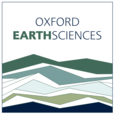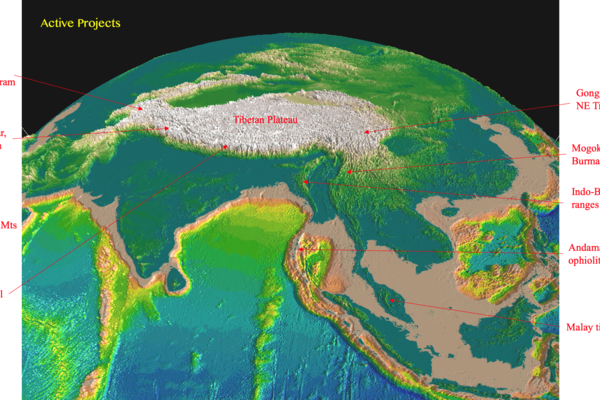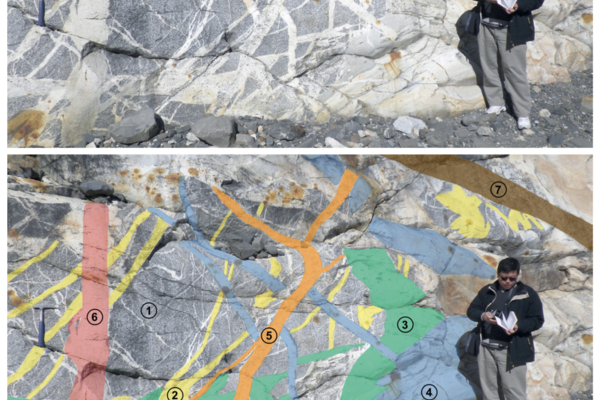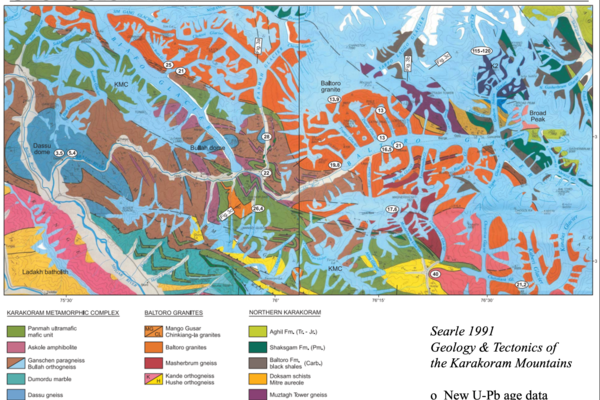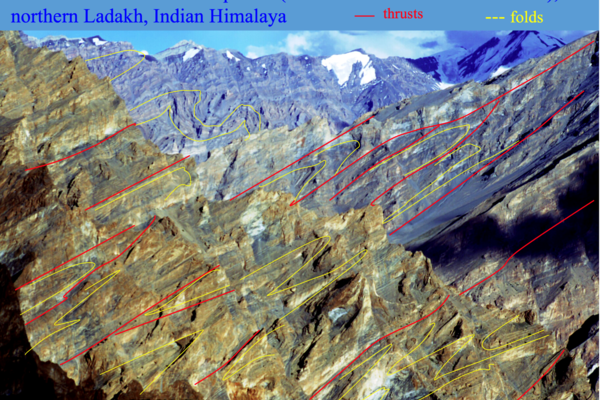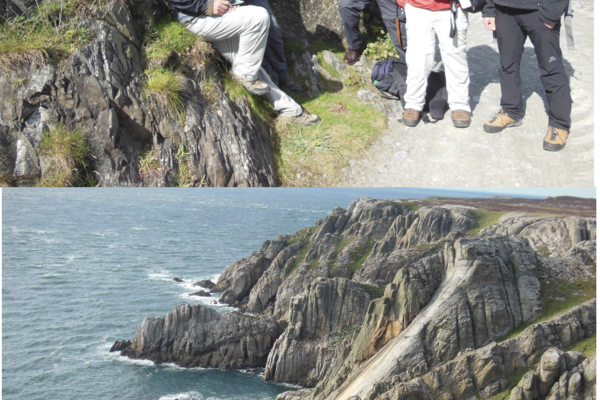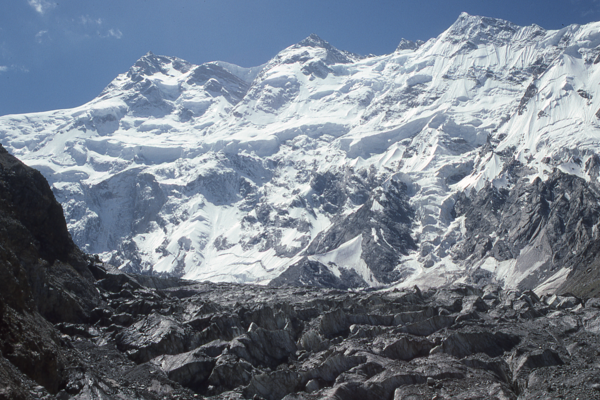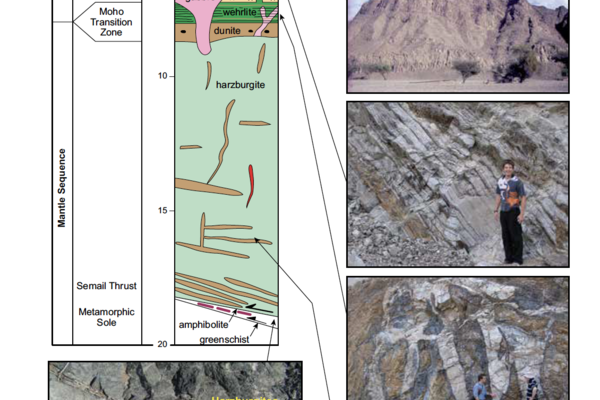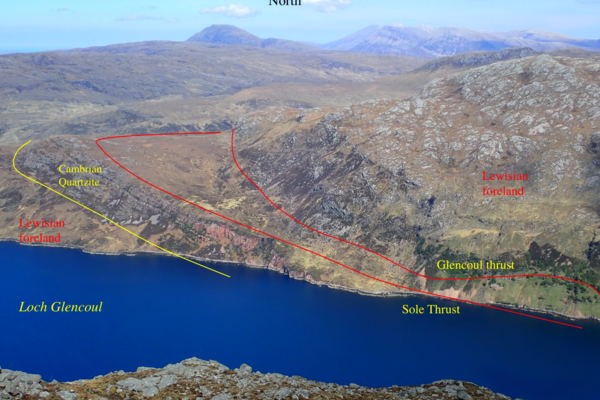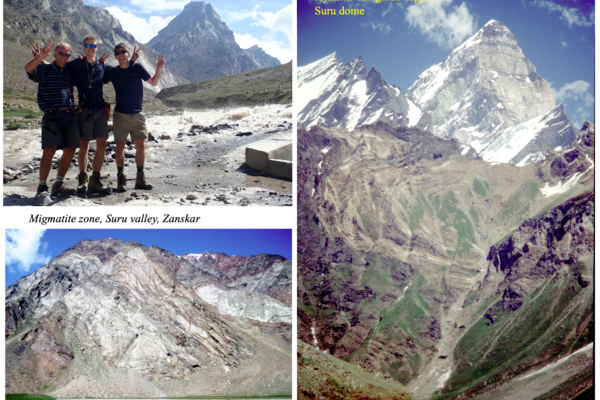Petrology, Economic, and Tectonic Research & Analysis (PETRA)
Research Group
Oxford's PETRA-HRG studies the structural and metamorphic geology of the Earth’s crust and its mineral resources. We address problems in tectonics and the origin of ore deposits through the application of mineralogy, petrology, structural geology, geochemistry and age determination.
Visit the PETRA website for more information.
SW England Tectonics and Structure
The Variscan granites of SW England are Permian (295-275 Ma) S-type granites containing tourmaline, lithium micas, rare topaz and are pervasively mineralised with tin (cassiterite) tungsten (wolframite), copper (chalcopyrite, bornite), arsenic (arsenopyrite) and zinc (sphalerite) mineralised lodes. We are working on all the main Cornubian granite plutons, and their metamorphic aureoles, especially on the Land’s End, Cligga Head, Tregonning, Carnmenellis, and St. Austell plutons, combining geology and geophysics (gravity, seismic, bathymetry, topography) to determine the shape, structure, and emplacement mechanism of the granite batholith.
Key Recent References
Searle, M.P., Shail, R.K., Pownall, J.M., Jurkowski, C., Watts, A.B., and Robb, L.J. 2024. The Permian Cornubian granite batholith, SW England: Part 1: Field, structural and petrological constraints. Geological Society of America Bulletin, https://doi.org/101130/B37457.1.
Watts, A.B., Xu, C., Searle, M.P., Jurkowski, C. and Shail, R.K. 2024. The Permian Cornubian granite batholith, SW England: Part 2: Gravity anomalies, structure, and state of isostasy. Geological Society of America Bulletin, https://doi.org/101130/B37459.1
Pownall, J.M., Waters, D.J., Searle, M.P., Shail, R.K. and Robb, L.J. 2012. Shallow laccolithic emplacement of the Land’s End and Tregonning granites, Cornwall, UK: Evidence from aureole field relations and P-T modeling of cordierite-anthophyllite hornfels. Geosphere, doi:10.1130/GES00802.1
The Devonian Lizard ophiolite complex in Cornwall is the largest exposed ophiolite in the Variscan orogenic belt and contains an almost complete section from mantle peridotites (lherzolites, harzburgites), Moho transition zone, crustal gabbros, up to the sheeted dykes. It has an extensive metamorphic sole around the base consisting of amphibolites, and greenschist facies assemblages, and an enigmatic sequence of granitoids around the base (Kennack gneiss). Our project involves field structural mapping, thermobarometry, geochemistry, and U-Pb zircon dating in order to unravel the origin and emplacement history of the Lizard complex.
Key References
Mackay-Champion, T., Searle, M.P., Tapster, S., Roberts, N.M.W., Shail, R.K., Palin, R.M., Willment, G.H. and Evans, J.T. 2024. Magmatic, Metamorphic and Structural History of the Variscan Lizard Ophiolite and metamorphic Sole, Cornwall, UK. Tectonics 43, e2023TC008187. https://doi.org/10.1029/2023TC008187
Lundy Island in the Bristol Channel is an anomalous peraluminous granite intrusion of similar mineralogy (quartz + plagioclase + K-feldspar + biotite ± garnet ± topaz) and mineralisation (tin, tungsten) as the Permian Cornubian granites, but has a U-Pb zircon age of 59.8 ± 0.4 Ma making it related to the British Cenozoic Igneous Province, and not to the Permian granites of Devon and Cornwall. The similarity of mineralogy and composition is the result of melting similar source rocks at different times.
Key Reference
Charles, J-H., Whitehouse, M.J., Andersen, J.C.Ø., Shail, R.K. and Searle, M.P. 2017. Age and petrogenesis of the Lundy granite: Paleocene intraplate peraluminous magmatism in the Bristol Channel, UK. Journal of Geological Society, London, https//doi.org/10.6084/m9.
Oman – United Arab Emirates ophiolite
The 96-95 Ma Semail ophiolite (Oman and UAE) is the largest, best exposed and most extensively studied ophiolite complex on Earth. Our project involves large scale structural mapping, microstructural analysis, thermobarometry, and detailed U-Pb dating of zircon from gabbros, and the amphibolite metamorphic sole. Geological studies are complimented by geophysical studies involving seismic imaging, gravity and magnetic profiles, and receiver functions, in collaboration with Khalifa University, Abu Dhabi.
Key Recent References
Pilia, S., Ali, M.Y., Watts, A.B. and Searle, M.P. 2016. UAE-Oman Mountains gives clues to oceanic crust and mantle rocks. Eos, 15th January 2016, v. 97 (2), p. 8-12.
Ambrose, T.K. and Searle, M.P. 2019. 3-D Structure of the Northern Oman – UAE Ophiolite: Widespread, short-lived, Supra-Subduction zone magmatism. Tectonics, 38, https://doi.org/10.1029/2018TC005038
Ali, M.Y., Watts, A.B., Searle, M.P., Keats, B., Pilian, S. and Ambrose, T. 2020. Geophysical imaging of ophiolite structure in the United Arab Emirates. Nature Communications, 267, https://doi.org/10.1038/s41467-020-16521-0
Searle, M.P., Rioux, M. and Garber, J.M. 2021. One Line on the map: A review of the geological history of the Semail Thrust, Oman – UAE Mountains. Journal of Structural Geology, 158, https://doi.org/10.1016/j.jsg.2022.104594
Levell, B., Searle, M.P., White, A., Kedar, L., Droste, H. and van Steenwinkel, M. 2021. Geological and seismic evidence for the tectonic evolution of the NE Oman continental margin and Gulf of Oman. Geosphere, 17, https://doi.org/10.1130/GES02376.1
Abdelmaksoud, A., Ali, M.Y. and Searle, M.P. 2022. Tectono-stratigraphic evolution of the foreland fold-and-thrust belt of the United Arab Emirates. Tectonics, 41, e2022TC007470, https://doi.org/10.1029/2022TC007470
Ismaiel, M., Ali, M.Y., Pilia, S., Watts, A.B. and Searle, M.P. 2023. Moho topography and crustal properties in the UAE and northern Oman mountain belt from teleseismic receiver functions. Geophysical Journal International, https://doi.org.1093/gji/ggad034
The metamorphic sole of the Semail ophiolite consists of an inverted profile the base of the ophiolite through garnet + clinopyroxene amphibolites (granulite facies), epidote amphibolites and greenschist facies meta-cherts and meta-carbonates. Peak PT conditions of formation are 700-900ºC, and 11-13 kbar, equivalent to ~40 km depth in a subduction zone beneath the Semail ophiolite. Synchronous U-Pb zircon ages from the ophiolite and the sole confirm a supra-subduction zone origin of the ophiolite. Our project involves large scale mapping, construction of balanced and restored cross-sections, microstructural analysis, thermobarometry, and detailed U-Pb and Sm-Nd dating of zircon, rutile and garnet, from about 15 localities along the mountain belt.
Key Recent References
Cowan, R.J., Searle, M.P. and Waters, D.J. 2014. Structure of the metamorphic sole to the Oman Ophiolite, Sumeini Window and Wadi Tayyin: implications for ophiolite obduction processes. In: Rollinson, H.R., Searle, M.P., Abbasi, I.A., Al-Lazki, A. and Al-Kindy, M.H. (Editors) Tectonic Evolution of the Oman Mountains. Geological Society of London Special Publication, 392, 149-169. http://dx.doi.org/10.1144/SP392.8
Rioux, M., Garber, J., Bauer, A., Bowring, S., Searle, M.P., Kelemen, P.B. and Hacker, B.R. 2016. Synchronous formation of the metamorphic sole and igneous crust of the Semail ophiolite: New constraints on the tectonic evolution during ophiolite formation from high-precision U-Pb zircon geochronology. Earth and Planetary Science Letters, v. 451, p. 185-195. https://doi.org/10.1016/j.epsl.20162016.06.051
Garber, J.M., Rioux, M., Kylander-Clark, Hacker, B.R., Vervoot, J.D. and Searle, M.P. 2020. Petrochronology of Wadi Tayin Metamorphic Sole metasediments, with implications for the thermal and tectonic evolution of the Samail Ophiolite (Oman/UAE). Tectonics, 10.1029/2020TC006135
Ambrose, T.K., Waters, D.J., Searle, M.P., Gopon, P., and Forshaw, J.B. 2021. Burial, Accretion, and Exhumation of the Metamorphic Sole of the Oman-UAE ophiolite. Tectonics, 40, https://doi.org/10.1029/2020TC006392
Rioux, M., Garber, J.M., Searle, M.P., Crowley, J.L., Stevens, S., Schmitz, M., Kylander-Clark, A., Leal, K., Ambrose, T. and Syme, A. 2023. The temporal evolution of subduction initiation in the Semail ophiolite: High-precision U-Pb zircon petrochronology of the metamorphic sole. Journal of Metamorphic Geology, 2023, 1-31. Doi: 10.1111/jmg.12719
In the As Sifah region of northern Oman a high-pressure belt, consisting of eclogites (20-23 kbar), blueschists (10-12 kbar) and extensive carpholite-bearing rocks (7-8 kbar) records the attempted subduction of the leading margin of the Arabian continental plate beneath the Semail Ophiolite during the later stages of ophiolite obduction. PT conditions 2.0 GPa and 550 – 600ºC record ultra-high pressure metamorphism at depths >100 km during the period ~81 – 77 Ma. Our project involves detailed mapping, micro-structural fabric analysis, combined with thermobarometry, and geochronology (U-Pb zircon, rutile) and Sm-Nd garnet).
Key Recent References
Agard, P., Searle, M.P., Alsop, G.I. & Dubacq, B. 2010. Crustal stacking and expulsion tectonics during continental subduction: P-T-deformation constraints from Oman. Tectonics, 29, TC5018, doi: 10.1029/2010TC002669.
Garber, J.M., Rioux, M., Searle, M.P., Kylander-Clark, A.R.C., Hacker, B.R., Vervoort, J.D., Warren, C.J., and Smye, A.J. 2021. Dating continental subduction beneath the Samail Ophiolite: Garnet, Zircon and Rutile petrochronology of the As Sifah eclogites, NE Oman. Journal Geophysical Research, Solid Earth, 10.1029/2021JB022715
Searle, M.P., Rioux, M. and Garber, J.M. 2021. One Line on the map: A review of the geological history of the Semail Thrust, Oman – UAE Mountains. Journal of Structural Geology, 158, https://doi.org/10.1016/j.jsg.2022.104594
The northern part of the Oman-UAE Mountains in the Musandam peninsula records a transition from Late Cretaceous ophiolite obduction tectonic regime in the SE to an early continent-continent collision along the Zagros Mountains in southern Iran. Our project involves detailed field mapping, surface structural mapping, and structural interpretation of the deep crust from seismic and well data, thermobarometry of the Bani Hamid granulites, and U-Pb dating.
Key References
Searle, M.P., Cherry, A.G., Ali, M.Y. and Cooper, D.J.W. 2014. Tectonics of the Musandam Peninsula and northern Oman Mountains: from ophiolite obduction to continental collision. GeoArabia, 19, 135-174.
Searle, M.P., Waters, D.J., Garber, J.M., Rioux, M., Cherry, A.G. and Ambrose, T.K. 2015. Structure and metamorphism beneath the obducting Oman ophiolite: Evidence from the Bani Hamid granulites, northern Oman mountains. Geosphere, v. 11, no. 6, doi:10.1130/GESO1199.1
Pilia, S., Ali, M.Y., Watts, A.B. and Searle, M.P. 2016. UAE-Oman Mountains gives clues to oceanic crust and mantle rocks. Eos, 15th January 2016, v. 97 (2), p. 8-12.
Pilia, S., Kaviani, A., Searle, M.P., Arroucau, P., Ali, M.Y., and Watts, A.B. 2021. Crustal and Mantle deformation inherited from obduction of the Semail Ophiolite (Oman) and continental collision (Zagros). Tectonics, https://doi.org/10.1029/2020TC006644
Himalaya
The collision of India with Asia and closing of the intervening NeoTethys ocean at ca 50 Ma resulted in crustal shortening and thickening along the Indian plate margin. Obduction of the Spontang ophiolite onto the north Indian plate margin preceded continental collision. Deformation propagated south (or SW) from the Tethyan Himalaya to the Greater Himalaya with time, culminating in kyanite grade regional metamorphism between ~45-35 Ma, and sillimanite grade regional metamorphism from ~35-12 Ma. At the highest temperatures, partial melting of pelitic gneisses resulted in migmatisation and formation of the classic Himalayan leucogranites with widespread magmatic tourmaline, garnet, biotite, muscovite, and rare andalusite and cordierite-bearing leucogranites. The Zanskar Himalaya has the greatest extent of kyanite grade metamorphism and field mapping along the Suru Valley shows large-scale recumbent folding and deep thrusting.
Key Recent References
Searle, M.P. 2015. Mountain Building, Tectonic evolution, Rheology and Crustal Flow in the Himalaya, Karakoram and Tibet. 2015. In: Watts, A.B. (Editor) Treatise on Geophysics, 2nd edition, v. 6, p. 469-511 http://dx.doi.org/10.1016/B978-0-444-53802-4.001221-4
Searle, M.P. 2018. Timing of subduction initiation, arc formation, ophiolite obduction and India-Asia collision in the Himalaya. In: Treloar, P.J. & Searle, M.P. (Eds) Himalayan Tectonics: A Modern Synthesis. Geological Society, London, Special Publication, 483. https://doi.org/10.1144/SP483.8
Cawood, I.P., St.Onge M.R., Weller, O.M, Searle, M.P. Waters, D.J., and Ahmad, T. 2024. The structural and metamorphic architecture of the Zanskar Himalaya in the Suru Valley, NW India: implications for formation of the Greater Himalayan Sequence. Tectonics, https://doi.org/10.1130/B37241.1
The Nepal Himalaya shows spectacular exposures of kyanite and sillimanite gneisses, migmatites and large leucogranites, emplaced as giant sill complexes along the top of the Greater Himalayan Slab, bounded above by a low-angle normal fault. the South Tibetan Detachment. Our project involves detailed regional mapping in the Annapurna – Manaslu Himalaya, the Langtang valley, around the Everest – Makalu region in both Nepal and south Tibet, combined with thermobarometry, metamorphic modelling, and U-Pb dating of zircons and monazites.
Key References
Searle, M.P., Cottle, J.M., Streule, M.J. and Waters, D.J. 2010. Crustal melt granitoids and migmatites along the Himalaya: melt source, segregation, transport and granite emplacement mechanisms. Transactions of the Royal Society of Edinburgh, v. 100, 219-233, doi:10.1017/SI75569100901617X
Streule, M.J., Searle, M.P., Waters, D.J. & Horstwood, M. 2011. Metamorphism, melting and channel flow in the Greater Himalayan Sequence and Makalu leucogranite: constraints from thermobarometry, metamorphic modeling and U-Pb geochronology. Tectonics, 29, TC5011, doi: 10.1029/2009TC002533
Law, R.D., Jessup, M.J., Searle, M.P., Francsis, M.K., Waters, D.J. & Cottle, J.M. 2011. Telescoping of isotherms beneath the South Tibetan Detachment System, Mount Everest Massif. Journal of Structural Geology, 33, 1569-1594, doi: 10.1016/jsg.2011.09.004
Cottle, J.M., Searle, M.P., Jessup, M., Crowley, J.L. and Law, R.D. 2015. Rongbuk Revisited: Geochronology of leucogranites in the footwall of the South Tibetan Detachment system, Everest region, Southern Tibet. Lithos, v. 227, p. 94-106, doi:http://dx.doi.org/10.1016/j.lithos.2015.03.019
Parsons, A.J., Phillips, R.J., Lloyd, G.E., Law, R.D., Searle, M.P. and Walshaw, R.D. 2016a. Mid-crustal deformation of the Annapurna-Dhaulagiri Himalaya, Central Nepal: an atypical example of channel flow during the Himalayan orogeny. Geosphere, v.12, no. 3, doi:10.1130/GESO1246.1
Parsons, A.J., Law, R.D., Lloyd, G.E., Phillips, R.J. and Searle, M.P. 2016b. Thermo-kinematic evolution of the Annapurna-Dhaulagiri Himalaya, central Nepal: The composite orogenic system. Geochemistry, Geophysics, Geosystems, v. 17 (4), p. 1511-1539, doi:10.1002/2015GC006184
Dyke, B., St-Onge, M., Searle, M.P., Rayner, N., Waters, D.J. and Weller, O.M. 2018. Protolith lithostratigraphy of the Greater Himalayan Series in Langtang, Nepal: implications for the architecture of the northern Indian margin. In: Treloar, P.J. & Searle, M.P. (Eds) Himalayan Tectonics: A Modern Synthesis. Geological Society, London, Special Publication 483. https://doi.org/10.1144/SP483.9
Searle, M.P. and Cottle, J.M. 2023. Structure and emplacement of leucogranites along the Manaslu – Himalchuli Range, Nepal. Journal of Nepal Geological Society, 65, 1-12.
The 25th April 2015 Gorkha earthquake (magnitude 7.8) in Nepal ruptured the Main Himalayan Thrust (MHT) for ~140 km from the epicenter north of Gorkha, eastwards towards the Mount Everest region. The earthquake nucleated at a depth of ~15-18 km, but did not rupture to the surface. Our project used geodetic measurements of surface displacement to determine about 1 meter of uplift of the mountains north of the Kathmandu valley, and 0.6 meter of subsidence in the Everest region, showing a northward tilt of the Himalaya during the earthquake. Our data suggest the earthquake ruptured above a ramp in the MHT. We link geological studies of the Cenozoic evolution of the Nepal Himalaya with the active tectonics and earthquake record.
Key References
Elliott, J.R., Jolivet, R., González, P.J., Avouac, J-P., Hollingsworth, J.C., Searle, M.P. and Stevens, V.L. 2016. Geometry of the Main Himalayan Thrust fault revealed by the Gorkha earthquake. Nature Geosciences, doi:10.1038/NGEO2623.
Searle, M.P., Avouac, J-P., Elliott, J. and Dyck, B. 2017. Ductile shearing to brittle thrusting along the Nepal Himalaya: linking Miocene channel flow and critical wedge tectonics to the 25th April 2015 Gorkha earthquake. Tectonophysics, http://dx.doi.org/10.1016/j.tecto.2016.08.003
The western Himalayan syntaxis is centered on the mountain of Nanga Parbat (8126 meters) in the Pakistan Himalaya and exposes high-grade sillimanite and cordierite-bearing gneisses and migmatites intruded by tourmaline, muscovite and garnet-bearing leucogranites. Our project combines monazite petrochronology with thermal modelling to evaluate the roles of crustal melting, surface denudation, and tectonics in processes of ultra-fast exhumation of deeply buried rocks. We determined a pulse of ultra-fast exhumation (9-13 mm/year) that began ~1 million years ago, and was preceded by a slower, but still rapid exhumation (2-5 mm/year). These rocks are the youngest crustal melt granites anywhere in the World and record the highest exhumation rates.
Key References
Crowley, J.L., Bowring, S.A., Waters, D.J., Searle, M.P., Hodges, K.V. & Ramezani, J. 2009. Timescale of accessory mineral growth in Pleistocene leucogranites and exhumation rates at Nanga Parbat, Pakistan Himalaya, Earth and Planetary Science Letters, 288, 408-420. Doi: 10.1016/j.epsl.2009.09.044
Boyce, J.W., Hodges, K.V., King, D., Crowley, J.L., Jercinovic, M., Chatterjee, N., Bowring, S.A. & Searle, M.P. 2009. Improved confidence in (U-Th)/He thermochronology using the laser microprobe: an example from a Pleistocene leucogranite, Nanga Parbat, Pakistan. Geochemistry, Geophysics, Geosystems 10, doi:10.1029/2009GC002497.
Guevara, V.E., Smye, A.J., Caddick, M., Searle, M.P., Olsen, T., Whalen, L., Kylander-Clark, A.R.C. 2022. A modern pulse of ultrafast exhumation and diachronous crustal melting in the Nanga Parbat massif. Science Advances, 8, eabm2689
Kohistan, Karakoram, Pamir ranges, central Asia
The Kohistan Island arc (Jurassic to Eocene) was a major intra-oceanic arc within NeoTethys between the Indian plate to the south and the Asian plate to the north. It comprises lower crust ultramafic rocks (Sapat complex), and HP garnet granulites (Jijal complex), gabbro-norites (Chilas complex) with amphibolites (Kamila amphibolites) and upper crustal arc volcanics, intruded by granites and granodiorites of the Late Cretaceous to Eocene Kohistan – Ladakh – Gangdese granites. The Karakoram terrane located along the southern margin of the Asian plate, includes the southern Karakoram metamorphic complex, the Miocene Baltoro granite batholith and the northern Karakoram - southern Pamir sedimentary zone. Our project involves regional field mapping, structural analysis, petrology, thermobarometry, metamorphic modelling and U-Pb zircon geochronology, with the aim of unravelling the tectonic evolution of the Asian plate during and after the India-Asia collision.
Key References
Searle, M.P., Parrish, R.R., Thow, A.V., Noble, S.R., Phillips, R.J. & Waters, D.J. 2010. Anatomy, age, and evolution of a collisional mountain belt: the Baltoro granite batholith and Karakoram Metamorphic Complex, Pakistani Karakoram. Journal of the Geological Society, London, 167,183-202, doi: 10.1144/0016-76492009-043.
Palin, R.M., Searle, M.P., Waters, D.J., Horstwood, M.S.A. & Parrish, R.R. 2012. Combined thermobarometry and geochronology of peraluminous metapelites from the Karakoram Metamorphic Complex, North Pakistan; New insights into the tectonothermal evolution of the Baltoro and Hunza Valley regions. Journal of Metamorphic Geology, doi: 10.1111/j.1525-1314.2012.00999.x
Searle, M.P. and Hacker, B.R. 2018. Structural and metamorphic evolution of the Karakoram and Pamir following India-Kohistan-Asia collision. In: Treloar, P.J. & Searle, M.P. (Eds) Himalayan Tectonics: A Modern Synthesis. Geological Society, London, Special Publication 483. https://doi.org/10.1144/SP483.6
Palin, R.M., Treloar, P.J., Searle, M.P., White, R.W., Mertz-Kraus, R. and Wald, T. 2018. U-Pb monazite ages from the Pakistan Himalaya record pre-Himalayan Ordovician orogeny and Permian continental break-up. Geological Society of America Bulletin, https://doi.org/10.1130/B31943.1
George, F.R., Waters, D.J., Gough, S.J., Searle, M.P. and Forshaw, J.B. 2021. Phase equilibria and microstructural constraints on the high-T building of the Kohistan Island arc: The Jijal garnet granulites, northern Pakistan. Journal of Metamorphic Geology, https://doi. 10.1111/jmg.12622
Tibet – structure, metamorphism, magmatism, and tectonics
Strike-slip faults in Tibet and SE Asia are key to the interpretation of the continental extrusion of Tibet hypothesis. We are studying the geology of the Lhasa Block, the southern margin of the Asian plate, and the major strike-slips involved in eastward extrusion, particularly the Karakoram fault, SW Tibet and Ladakh, the Red River fault, Yunnan and north Vietnam, the Xianshui-he fault in Eastern Tibet, and the Sagaing fault in Myanmar. These projects all involve field mapping, structural mapping, combined with U-Th-Pb geochronology, with the aim of determining the amount of geological offsets and timing of slip along these faults.
Key Recent References
Searle, M.P., Elliott, J.R., Phillips, R.J. & Chung, S-L. 2011. Crustal-Lithospheric structure, geological evolution and continental extrusion of Tibet. Journal of the Geological Society, London, 167, 633-672, doi: 10.1144/0016-76492010-139.
Weller, O.M., St-Onge, M.R., Waters, D.J., Rayner, N., Searle, M.P., Chung, S-L., Palin, R.M., Lee, Y-H. and Xu, X. 2013. Quantifying Barrovian metamorphism in the Danba Structural Culmination of eastern Tibet. Journal of Metamorphic Geology, doi:10.1111/jmg/12050
Phillips, R.J., Searle, M.P. and Parrish, R.R. 2013. The geochemical and temporal evolution of the continental lithosphere and its relationship to continental-scale faulting: The Karakoram Fault, eastern Karakoram, NW Himalayas. Geochemistry, Geophysics, Geosystems, 14, 3, doi:10.1002/ggge.20061
Palin, R.M., Searle, M.P., Morley, C.K., Charusiri, P., Hortswood, M.S.A. and Roberts, N.M.W. 2013b. Timing of metamorphism of the Lansang gneiss and implications for left-lateral motion along the Mae Ping (Wang Chao) strike-slip fault, Thailand. Journal of Asian Earth Sciences, doi.org/10.1016/j.seaes.2013.01.0121
Palin, R.M., Searle, M.P., St-Onge, M.R., Waters, D.J., Roberts, N.M.W., Horstwood, M.S.A., Parrish, R.R. & Weller, O.M. 2015. Two-stage cooling history of pelitic and semi-pelitic mylonite (sensu lato) from the Donjiu-Milin shear zone, northwest flank of the eastern Himalayan syntaxis. Gondwana Research, doi: org/10.1016/j.gr.2014.07.009
Weller, O.M., St-Onge, M.R., Searle, M.P., Waters, D.J., Rayner, N., Chung, S-L., Palin, R. and Chen, S. 2015. Quantifying the P-T-t conditions of north-south Lhasa terrane accretion: new insights into the pre-Himalayan architecture of the Tibetan plateau. Journal of Metamorphic Geology, 33, 91-113; doi:10.1111/jmg.12112
Searle, M.P., Roberts, N.M.W., Chung, S-L., Lee, Y-H., Cook, K., Elliott, J.R., Weller, O.M., St-Onge, M.R., Xu, X-W., Tan, X-B. and Li, K. 2016. Age and anatomy of the Gongga Shan batholith, eastern Tibetan Plateau, and its relationship to the active Xianshui-he fault. Geosphere, v. 12, no. 3, doi:10.1130/GESO1244.1
Weller, O.M., St-Onge, M.R., Rayner, N., Searle, M.P., and Waters, D.J. 2016. Miocene magmatism in the Western Nyainqentanglha mountains of southern Tibet: An exhumed bright spot? Lithos, http://dx.doi.org/10.1016/j.lithos.2015.06.024
Sloan, R.A., Elliott, J.R., Searle, M.P. and Morley, C.K. 2017. Ch. 2. Active Tectonics of Myanmar and the Andaman Sea. In: Barber, A.J., Khin Zaw, and Crow, M.J. (Eds): Geology of Myanmar (Burma). Geological Society of London Memoir, 48,19-52, https://doi.org/10.1144/M48.2.
South-East Asia
The Hpakan – Taw Maw region of northern Myanmar hosts extensive deposits of World-class Jade, including jadeitites, rare Cr-rich jadeite (mawsitsit), Cr-rich clinopyroxene (kosmochlore) and albitite. This project studies ophiolites around Lake Indawgyi and samples from the Jade Mines. Our U-Pb zircon age from gabbros associated with the Jade Mines peridotites (169.71 ± 1.3 Ma) correlates well with similar un-metamorphosed ophiolites along the Myitkyina ophiolite belt (173 Ma). This project intends to fingerprint Burmese jade using petrology, Electron microprobe analyses, geochemistry, isotopes and LA-ICPMS.
Key References
Searle, M.P., Morley, C.K., Waters, D.J., Gardiner, N.J., U Kyi Htun and Robb, L.J. 2017. Ch. 12. Tectonics of the Mogok Metamorphic belt, Myanmar (Burma) and its correlations from the East Himalayan Syntaxis to the Malay Peninsula. In: Barber, A.J., Khin Zaw, and Crow, M.J. (Eds): Geology of Myanmar (Burma). Geological Society of London Memoir, 48, 261-293. http://doi.org/10.1144/M48.12
Searle, M.P., Palin, R.M., Gardiner, N.G., Kyi Htun and Wade, J. 2023. The Burmese Jade Mines belt: origins of jadeites, serpentinites, and ophiolitic peridotites and gabbros. Journal of the Geological Society, London, https://doi.org/10.1144/jgs2023-004
The Mogok metamorphic belt in Myanmar (Burma) extends for 1000 km from the East Himalayan syntaxis south to the Andaman Sea, in Myanmar. It consists dominantly of high-grade marbles which host the World’s best quality rubies, skarn deposits which host blue sapphires, and many other rare gems. Syenites and charnokites form sheet-like intrusions into the marbles and have three different age groups, Jurassic (170-168 Ma), late Cretaceous – Paleocene (68-63 Ma) and late Eocene-Oligocene (44-21 Ma). Our project involves mapping, petrology, thermobarometry, and U-Pb zircon and titanite dating around many of the ruby-sapphire mines in the Mogok region.
Key References
Searle, M.P., Morley, C.K., Waters, D.J., Gardiner, N.J., U Kyi Htun and Robb, L.J. 2017. Ch. 12. Tectonics of the Mogok Metamorphic belt, Myanmar (Burma) and its correlations from the East Himalayan Syntaxis to the Malay Peninsula. In: Barber, A.J., Khin Zaw, and Crow, M.J. (Eds): Geology of Myanmar (Burma). Geological Society of London Memoir, 48, 261-293. http://doi.org/10.1144/M48.12
Searle, M.P., Garber, J.M., Hacker, B.R., Kyi Htun, Gardiner, N.J., Waters, D.J. and Robb, L.J. 2020. Timing of syenite – Charnokite magmatism and ruby and sapphire metamorphism in the Mogok valley region, Myanmar. Tectonics, 39, doi: 10.1029/2019TC005998
Lamont, T.N., Searle, M.P., Hacker, B.R., Kyi Htun, Kyaw Min Htun, Morley, C.K., Waters, D.J. and White, R.W. 2021. Late Eocene – Oligocene granulite facies garnet-sillimanite migmatites from the Mogok Metamorphic Belt, Myanmar, and implications for timing of slip along the Sagaing Fault. Lithos, https://doi.org/10.1016/j.lithos.2021.106027
Searle, M.P., Palin, R.M., Gardiner, N.G., Kyi Htun and Wade, J. 2023. The Burmese Jade Mines belt: origins of jadeites, serpentinites, and ophiolitic peridotites and gabbros. Journal of the Geological Society, London, https://doi.org/10.1144/jgs2023-004
The Indo-Burma ranges along the western border of Myanmar show extensive, highly deformed Triassic turbidites (Pane Caung Fm.), and four ophiolite complexes, with the Kaleymo ophiolite having an Early Cretaceous age similar to ophiolites along the Indus-Tsangpo suture zone in Tibet, and the Nagaland ophiolite in NE India. Our project involves, structural mapping, biostratigraphy, detrital zircon dating, and tectonic interpretation of the eastern margin of the indenting Indian plate. This suture zone extends south to the Andaman Islands where we have also studied the ophiolite, and the forearc region to the active volcanic arc (Barren Island volcano).
Key References
Pedersen, R.B., Searle, M.P., Carter, A. & Bandopadhyay, P.C. 2010. U-Pb zircon age of the Andaman ophiolite: implications for the beginning of subduction beneath the Andaman – Sumatra arc. Journal of the Geological Society, London, 167, 1105-1112, doi: 10.1144/0016-76492009-151
Morley, C.K. and Searle, M.P. 2017. Ch. 5. Regional tectonics, structure and evolution of the Andaman – Nicobar Islands from ophiolite formation and obduction to collision and back-arc spreading. In: Bandopadhyay, P.C. and Carter, A. (eds). The Andaman – Nicobar accretionary ridge: Geology, Tectonics and Hazards. Geological Society, London Memoir 47, 51-74. https://doi.org/10.1144/jgs2017-023
Morley, C.K., Naing, T-T., Searle, M.P. and Robinson, S.A. 2020. Structural and tectonics development of the Indo-Burma Ranges. Earth Science Reviews, https://doi.org/10.1016/j.earscirev.2019/102992
Naing, Tin Tin, Robinson, S.A., Searle, M.P., Morley, C.K., Millar, I., Green, O.R., Bown, P.R., Danelian, T., Petrizzo, M.R. and Henderson, G.M. 2023. Age, depositional history and tectonics of the Indo-Myanmar Ranges, Myanmar. Journal of Geological Society, London, v. 180 https://doi.org/10.1144/jgs2022-091.
The South Myanmar – Thailand (Phuket Island) – west Malaysia Main Range province consists of biotite-K-feldspar (± garnet, ± tourmaline) S-type granites, which are associated with the World’s largest tin deposits in greisen-type veins. These granites result from crustal thickening following the collision of Sibumasu with Indo-China in the Triassic. Our project involves regional mapping, and sampling across the whole Malay peninsula for geochemistry, isotopes and U-Pb zircon dating.
Key References
Searle, M.P., Whitehouse, M.J., Robb, L.J., Ghani, A.A., Hutchison, C.S., Sone, M., Ng, S.W-P., Roselee, M.H., Chung, S-L. & Oliver, G.J.H. 2012. Tectonic evolution of the Sibumasu-Indochina terrane collision zone in Thailand and Malaysia: constraints from U-Pb zircon chronology of SE Asian tin granitoids. Journal of Geological Society, London, doi: 10.1144/0016-7492011-1076
Gardiner, N.J., Robb, L.J. & Searle, M.P. 2014. The Metallogenic Provinces of Myanmar. Applied Earth Sciences, 123. doi: 10.1179/1743275814Y.0000000049
Ng, S. W-P., Chung, S-L., Robb, L.J., Searle, M.P., Ghani, A.A., Whitehouse, M.J., Oliver, G.J.H., Sone, M., Gardiner, N.J. and Roselee, M.H. 2015a. Petrogenesis of Malaysian granitoids in the Southeast Asia Tin Belt: Part 1. Geochemical and Sr-Nd isotopic characteristics. Geological Society of America Bulletin, doi:10.1130/B31213.1.
Ng, S. W-P., Whitehouse, M.J., Searle, M.P., Robb, L.J., Ghani, A.A., Oliver, G.J.H., Sone, M., Gardiner, N.J. and Roselee, M.H. 2015b. Petrogenesis of Malaysian granitoids in the Southeast Asian Tin Belt: Part 2. U-Pb zircon geochronology and tectonic model. Geological Society of America Bulletin, doi:10.1130/B31 214.1
Gardiner, N.J., Searle, M.P. and Robb, L.J. 2015a. Neo-Tethyan Magmatism and Metallogeny in Myanmar – an Andean Analogue? Journal of Asian Earth Sciences. doi:10.1016/j.jseaes.2015.03.015
Gardiner, N.J., Searle, M.P., Morley, C.K., Whitehouse, M.J., Spencer, C.J. and Robb, L.J. 2015b. The closure of Palaeo-Tethys in Eastern Myanmar and Northern Thailand New Insights from zircon U-Pb and Hf isotope data. Gondwana Research, doi.org10.1016/j/seaes.2015.03.015
Searle, M.P., Robb, L.J., and Gardiner, N.J. 2016. Tectonic processes and metallogeny along the Tethyan mountain ranges of the Middle East and South Asia (Oman, Himalaya, Karakoram, Tibet, Myanmar, Thailand, Malaysia). Society of Economic Geologists, Special Publication v. 19, p. 301-327.
Aegean Islands, Greece
The metamorphic core complexes of Naxos and Ios Islands are compressional in origin with high-grade kyanite- and sillimanite gneisses in the core and extensional faults around the margin. Older high-pressure blueschists and eclogites record an early subduction related metamorphism. ‘Extensional’ faults related to exhumation of blueschists, and exhumation of the regional Barrovian metamorphic core rocks occurred in a compressional setting. Only the last phase of low-angle normal faulting relates to regional Aegean Sea extension. Our project involves regional mapping, strain analysis, petrological modelling, thermobarometry, and U-Pb geochronology, with the aim of unravelling the tectonic evolution of the Aegean Orogeny.
Key References
Searle, Michael and Lamont, Thomas, 2019. Compressional metamorphic core complexes, low-angle normal faults and extensional fabrics in compressional tectonic settings. Geological Magazine, https://doi.org/10.1017/S0016756819000207
Lamont, T.N., Searle, M.P., Waters, D.J., Roberts, N.M.W., Palin, R.M., Smye, A.J., Dyke, B. Gopon, P., Weller, O.M. and St-Onge, M.R. 2020. Compressional origin of the Naxos metamorphic core complex, Greece: Geological Society of America Bulletin, 132, no ½, 149-197. https://doi.org/10.1130/B31978.1.
Searle. M.P., and Lamont, T.N. 2022. Compressional origin of the Aegean Orogeny, Greece. Geoscience Frontiers, 13, 101049
The HP-LT rocks on Tinos Island include lawsonite- garnet- and glaucophane-bearing schists metamorphosed at 22-26 kbar and 490-520ºC. Eclogites containing aegirine omphacite and chromium-rich kosmochlore on Syros Island formed at pressure around 20-23 kbar. Exhumation of these HP rocks from the subduction zone occurred during the late stage of ophiolite emplacement, and assisted uplift of footwall rocks below a passive roof fault. Our project on Tinos and Syros Islands in the Aegean Sea involves regional mapping, detailed petrology, thermobarometry and metamorphic modelling, as well as U-Pb geochronology.
Key References
Lamont, T.N., Searle, M.P., Gopon, P., Roberts, N.M.W., Wade, J., Palin, R.M. and Waters, D.J. 2020b. The Cycladic Blueschist unit on Tinos, Greece: Cold NE subduction and SW directed extrusion of the Cycladic continental margin under the Tsniknias Ophiolite. Tectonics, 39, https://doi.org10.1029/20191TC005890
Searle. M.P., and Lamont, T.N. 2022. Compressional origin of the Aegean Orogeny, Greece. Geoscience Frontiers, 13, 101049
Lamont, T.N., Smye, A.J., Roberts, N.M.W., Searle M.P., Waters, D.J. and White, R.W. 2023a. Constraints on the thermal evolution of metamorphic core complexes from the high-pressure metamorphism on Naxos, Greece. Geological Society of America, Bulletin. https://doi.org/10/1130/B36332.1
The Tsniknias Island ophiolite is the best preserved obducted ophiolite in the Aegean Islands, and shows an amphibolite metamorphic sole accreted to the base of the harzburgite – lherzolite mantle sequence. The sole rocks comprise upper amphibolites and lower greenschist – blueschist facies meta-sediments. A plagiogranite intruded in the crustal sequence has a U-Pb zircon date of 161.9 ± 2.8 Ma. Partial melting occurred during subduction at ~ 74 Ma and the ophiolite was obducted some 90 m.y. after formation. Subduction beneath resulted in regional blueschist terrain exposed around the island of Tinos and HP eclogites on Syros Island.
Key References
Lamont, T.N., Roberts, N.M.W., Searle, M.P., Gopon, P., Waters, D.J. and Millar, I. 2019. The age, origin and emplacement of the Tsiknias Ophiolite, Tinos, Greece. Tectonics, 38. https://doi.org/10.1029/2019TC005677
On the islands of Tinos, Delos, Mykonos, and Naxos in the Aegean Sea, Greece both hornblende, biotite bearing I-type granites and garnet + muscovite S-type granites occur together. U-Pb zircon ages suggest they formed simultaneously at ~15 – 14 Ma. The I-type granites are not related to Hellenic subduction but formed from dehydration melting of Variscan basement, whereas the S-type granites formed from muscovite-dehydration melting of a sedimentary protolith. Granite composition is related to different source rocks at different depths, at the same time. In this project we use field structural mapping, combined with major and trace-element geochemistry, Sr-Nd isotopes and U-Pb geochronology to constrain granite origin, and the tectonic evolution of the Aegean region.
Key References
Lamont, T.N., Roberts, N.M.W., Searle, M.P., Gardiner, N.J., Gopon, P., Hseih, Y-T., Holdship, P. and White, R.W. 2023b. Contemporaneous crust-derived I- and S-type granite magmatism and normal faulting on Tinos, Delos, and Naxos, Greece: Constraints on Aegean orogenic collapse. Geological Society of America, Bulletin. https://doi,org/10.1130/B36489.1
Geology of NW Scotland
The Moine thrust belt in NW Scotland is the western margin of the Caledonian orogenic belt in Britain and is a classic fold-and-thrust belt that has been studied for more than100 years. New mapping in the Loch Eriboll and Assynt Window regions combined with restoration of balanced cross-sections has enabled a more detailed geometric analysis of the Moine thrust belt. The relationship of alkaline intrusions such as the Loch Ailsh syenites, Borralan intrusion and suite of lamprophyre dykes and sills, with thrusts enable us to constrain the sequence of thrusting in greater detail. Our project extends across the Northern Highlands with recent new work on the island of Mull constraining the P-T conditions and age of metamorphism of kyanite and sillimanite gneisses. We are also studying the relationships between the ~430-420 Ma ‘Newer granite’ suite with lamprophyre magmatism across the Northern Highlands and Grampian terranes.
Key References
Searle, M.P., Law, R.D., Dewey, J.F. & Streule, M.J. 2010. Relationship between the Loch Ailsh and Borralan alkaline intrusions and thrusting in the Moine Thrust zone, southern Assynt culmination, NW Scotland. In: Law, R.D. et al. (eds) Continental Tectonics and Mountain Building: The Legacy of Peach and Horne. Geological Society, London Special Publication, 335, 383-404. Doi: 10.1144/SP335.18 0305-8719/10.
Searle, M.P., Cornish, S.B., Heard, A., Charles, J-H., and Branch, J. 2019. Structure of the Moine Thrust zone, Loch Eriboll, Scottish Caledonides. Tectonophysics 752, 35-51 https://doi.org/10.1016/j.tecto.2018.12.016
Searle, M.P. 2021. Tectonic evolution of the Caledonian orogeny in Scotland: a review based on the timing of magmatism, metamorphism and deformation. Geological Magazine, https://doi.org/10.1017/S0016756821000947
Fox, R. and Searle, M.P. 2021. Structural. Petrological, and tectonic constraints on the Loch Borralan and Loch Ailsh alkaline intrusions, Moine Thrust zone, northwestern Scotland. Geosphere, 17, https://doi.org/10.1130/GES02330.1
Searle, M.P. 2023. Structure of the Assynt Window, Moine Thrust zone, and relationship to alkaline igneous complexes, Caledonian orogeny, NW Scotland. Geological Magazine, https://doi.org/10.1017/S0016756823000511

